Berezlet family. There are more than 200 species in nature. Homeland - areas with a temperate and subtropical climate in Australia, East Asia, Japan, North America, Europe, some species are found in Madagascar, others in the foothills of the Himalayas. All parts of the plant in the birch bark are poisonous. We consider species that can be grown in indoor conditions (taking into account the possibility of cold wintering).
- Japanese euonymus japonicus is an evergreen tree shrub native to Japan and China. In nature, it reaches a height of 2-5 m, elliptical leaves on very short petioles, about 7 cm long, 3-3.5 cm wide, finely toothed along the edge. Flowers about 5 mm in diameter are white-green. There are many variegated varieties. The original species has pure green leaves.
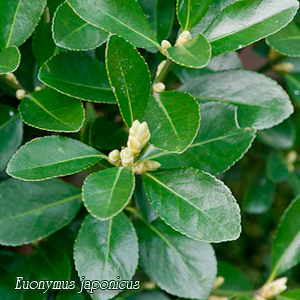
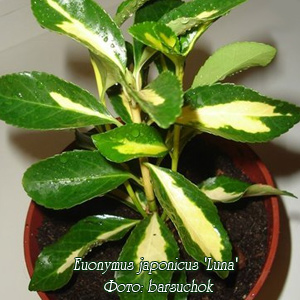
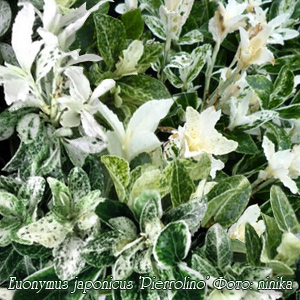
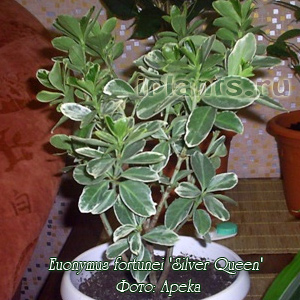
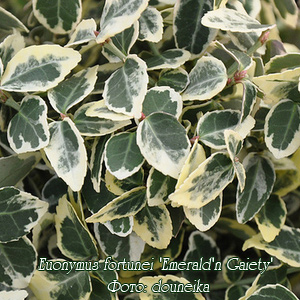

- Euonymus fortunei, an evergreen shrub, has erect, then creeping long shoots. Interestingly, its stems stretch upward like ivy or loach, looking for support, in natural conditions the length of the stems can reach 20 m in length, small aerial roots are formed on the stem. The leaves are leathery, elliptically ovate, with a serrated margin, 5-6 cm long, 3-5 cm wide. The flowers are about 5 mm in diameter and cream-green in color. The fruit is a tetrahedral pod. There are several variegated varieties.
To form the crown in the spring, pruning is carried out, which the birch bark tolerates very well, as well as pinching the apical buds.
Beresclet - care and cultivation
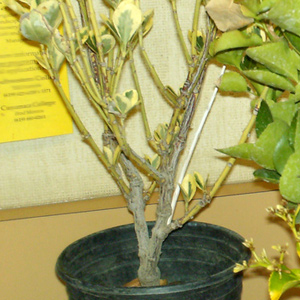
Temperature: In summer, the usual room temperature, although the birch bark prefers a moderate temperature, optimally 20-22 ° C. In winter, cool content is required at 12-13 ° C. With warmer content in winter, the plant continues to grow, but at the same time it stretches out if there is little light, and at the same time sheds the lower leaves, the stems are exposed, and decorative attractiveness is lost (photo on the right). In summer, it is advisable to grow birch bark in the fresh air in partial shade, in the garden or on the balcony. Birchlets, first of all, garden plants, they tolerate small frosts if they are covered for the winter, but plants planted in pots cannot be kept at subzero temperatures, for them the winter minimum is + 2 ° С.
Lighting: Bright diffused light with little direct sunlight in the morning or evening. The variegated birch bark gets used to the sun and even on the south window may not need shading.
Watering: Plentiful from spring to autumn. The soil of the birch bark should be slightly moist all the time in the depths of the roots, but by the next watering it is imperative to dry out in the upper third of the pot. In winter, watering is moderate or limited, depending on the temperature, the soil should dry out almost completely. Plants that stand on an insulated balcony at a temperature of 5-10 ° C practically do not water at all. Plants do not shed leaves, but are at rest.
Air humidity: High, optimal not lower than 50%, periodic spraying is required. If the indoor air is very dry, or there is dry hot weather outside, the birch bark is subject to tick attack. To avoid this, potted birchlets can periodically have a hot shower (the water temperature is such that the hand can easily tolerate). At the same time, the soil in the pot must be covered with a film to protect against excessive dampness.
Transplant: Carried out in spring, in March - April. The soil is the 3 part of the sod, the 1 part of the humus, the 1 part of the sheet earth and the 1/2 of sand. Birch bark is grown in pots and tubs, on the bottom of which it is imperative to pour drainage. Birch bark prefers soils with pH = 6.5-7, does not like strongly alkaline soils and acidic ones. At the same time, the soil should be very loose, well breathable, i.e. heavy clay soils are not suitable. To add looseness to the soil, small expanded clay (2-3 mm) and vermiculite are added to it, in an amount of 1/5 of the total volume of the earth.
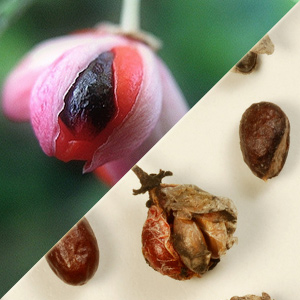
Room birch bark: reproduction
Cuttings early in spring, they easily root in water in spring or vermiculite. Also, the euklet is propagated by dividing the bush and root offspring.
You can propagate the birch bark with seeds. This requires two-step pre-stratification. The fact is that the seeds of the birch bark are characterized by a combination of underdevelopment of the embryo and a physiological mechanism for inhibiting germination. I.e. specifically in the birch bark, the embryo is large, good, but slightly underdeveloped. Therefore, the first stage is aimed at the development of the seed embryo, the sign of the completion of which is the opening of the seeds. The seeds increase somewhat in size, its peel cracks. So, the seeds are stored for about 2 months in a humid environment. It could be sphagnum moss.
After harvesting, I etched the seeds in a strong solution of manganese, then put them in moist moss, which should not be raw, but only slightly moist. If the seeds are dry, they must first be soaked for three days in water, then etched. Place the seed plate in a cool place, where the temperature is about 10-12 ° C (not higher than 15 ° C), for 2 months (October-November). During this time, the bulk of the seeds should crack (ripen). The most unpleasant thing in the first stage of stratification is that the seeds can become moldy. The first time I did it, the seeds were gone. The next time I constantly examined them (I did not get the seeds, but looked at the state of moss), ventilated and moisturized them with the addition of fundazole (once a month). At the second stage, when stored in the refrigerator, mold could no longer be feared.
So, the second stage is aimed at eliminating the physiological braking mechanism - the seed must be rearranged to an even cooler place, where the temperature is + 2-3 ° C (refrigerator), and kept for about 5 months. After this time (in April-May), seeds can be planted. For all the time of stratification, it is important that the seeds are not dried or waterlogged. I.e. periodically moisten from the spray bottle, very little. Why moss is needed - if you place the seeds in peat or sand, you will have to moisten abundantly to reach the seeds, and so, one spray spray. For planting, I used a mixture of coconut substrate, sand and sheet earth.
Pests of the Eurosclet
As mentioned above, birch bark is very fond of ticks, which are almost invisible on the leaves until yellowing and leaf fall begin. Also a sign of ticks is leaf deformation - curvature, especially of young leaves. Knowing the tendency of ticks to attack birch bark, it is easier to maintain high humidity, especially during hot times, occasionally wash the leaves in a hot shower (water temperature 45 ° C), you can with shampoo or soap (any). Why I do not propose to treat with acaricides (in extreme cases, you have to use them) - because ticks become resistant to them, and still survive. Garden birchlets can be powdered with colloidal sulfur.
Another attack of birch bark is a shield, there is even such a view - a birch bark shield. Although any other species of scale insects can attack the plant. You can fight them with systemic insecticides - actara or confidor, and remove pests from leaves and stems manually - with a cotton swab or sponge.